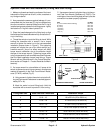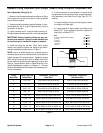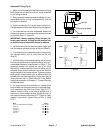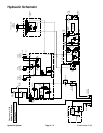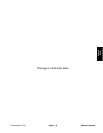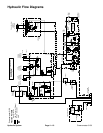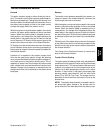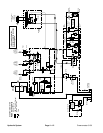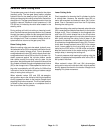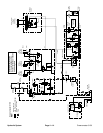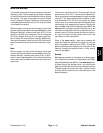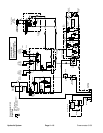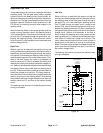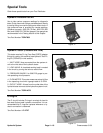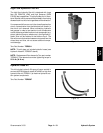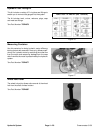
Greensmaster 3150 Hydraulic SystemPage 4 -- 13
Raise and Lower Cutting Units
The tandem gear pump is directly coupled to the piston
(traction) pump. The rear gear pump section supplies
hydraulic flow for the steering circuit (priority flow), for
raising and lowering the cutting units and for the traction
charge circuit. The gear pump takes its suction from the
hydraulic reservoir. Maximum circuit pressure of 1160
PSI (80 bar) is limited by the relief valve located in the
steering valve.
During cutting unit hold (not raising or lowering) condi-
tions, flowfrom the rear gear pump sectionis by--passed
through the steering valve and de--energized solenoid
valve (S2) in the hydraulic manifold directly to the trac-
tion charge circuit. Flow in excess of charge circuit re-
quirements then returns to the gear pump inlet.
Raise Cutting Units
When the cutting units are to be raised, hydraulic man-
ifold solenoid valve (S2) is energized and blocks flow di-
rectly to the traction charge circuit. Flow is directed to
energized solenoid valve (S3), which directs flow to de --
energized solenoid valve (S4) and the lift cylinders. Hy-
draulic pressure against the cylinder pistons moves
their shafts causing the cutting units to r aise. At the
same time, the pistons push the hydraulic fluid out of the
lift cylinders and back through energized solenoid valve
(S3) to the charge circuit. Raise speed for the front cut-
ting units is controlled by a 0.055 orifice. A 0.030 orifice
in the return line f or the center cutting unit allows a slight
delay in raising that cutting unit.
When solenoid valves (S2) and (S3) de--energize,
spring action returns the valves to their original position
and by--passes flow back to the traction charge circuit
stopping lift cylinder movement. The lift cylinder position
is locked in place since there is no complete circuit of
flow to and from the lift cylinders.
Lower Cutting Units
Circuit operation for lowering the lift cylinders is similar
to raising them. However, the solenoid valve (S3) re-
mains de--energized and solenoid valve (S4) is ener-
gized. Flow is reversed to and from the lift cylinders,
lowering the cutting units.
When the cutting units are to be lowered, solenoid valve
(S2) is energized and blocks flow directly to the traction
charge circuit. Flow is directed to de--energized sole-
noid valve (S3), which directs flow to the lift cylinders.
Hydraulic pressure against the cylinder pistons moves
their shafts causing the cutting units to lower. At the
same time, the pistons push the hydraulic fluid out of the
lift cylinders to energized solenoid valve (S4). Flow con-
tinues back through solenoid valve (S3) to the charge
circuit. Lower speed for the front cutting units is con-
trolled by the 0.055 orifice. A 0.030 orifice and adjust-
able flow control valve for the center cutting unit allows
a slight delay in lowering that cutting unit.
To control pressure while lowering the cutting units, the
system is equipped with adjustable relief valve (R2) in
the hydraulic manifold.
When solenoid valves (S2) and (S4) de--energize,
spring action returns the valves to their original position
and by--passes flow back to the traction charge circuit
stopping lift cylinder movement.
Hydraulic
System



